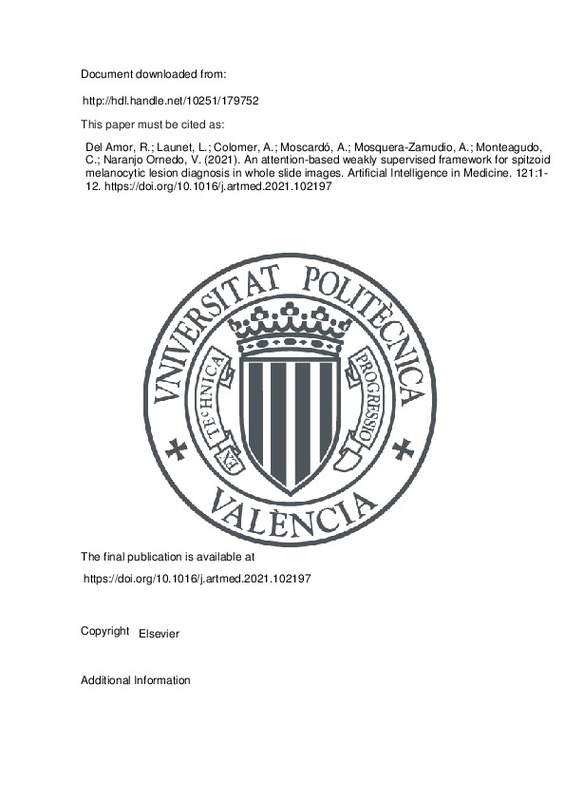JavaScript is disabled for your browser. Some features of this site may not work without it.
Buscar en RiuNet
Listar
Mi cuenta
Estadísticas
Ayuda RiuNet
Admin. UPV
An attention-based weakly supervised framework for spitzoid melanocytic lesion diagnosis in whole slide images
Mostrar el registro sencillo del ítem
Ficheros en el ítem
| dc.contributor.author | del Amor, Rocío
|
es_ES |
| dc.contributor.author | Launet, Laetitia
|
es_ES |
| dc.contributor.author | Colomer, Adrián
|
es_ES |
| dc.contributor.author | Moscardó, Anaïs
|
es_ES |
| dc.contributor.author | Mosquera-Zamudio, Andrés
|
es_ES |
| dc.contributor.author | Monteagudo, Carlos
|
es_ES |
| dc.contributor.author | Naranjo Ornedo, Valeriana
|
es_ES |
| dc.date.accessioned | 2022-01-17T19:26:59Z | |
| dc.date.available | 2022-01-17T19:26:59Z | |
| dc.date.issued | 2021-11 | es_ES |
| dc.identifier.issn | 0933-3657 | es_ES |
| dc.identifier.uri | http://hdl.handle.net/10251/179752 | |
| dc.description.abstract | [EN] Melanoma is an aggressive neoplasm responsible for the majority of deaths from skin cancer. Specifically, spitzoid melanocytic tumors are one of the most challenging melanocytic lesions due to their ambiguous morphological features. The gold standard for its diagnosis and prognosis is the analysis of skin biopsies. In this process, dermatopathologists visualize skin histology slides under a microscope, in a highly time-consuming and subjective task. In the last years, computer-aided diagnosis (CAD) systems have emerged as a promising tool that could support pathologists in daily clinical practice. Nevertheless, no automatic CAD systems have yet been proposed for the analysis of spitzoid lesions. Regarding common melanoma, no system allows both the selection of the tumor region and the prediction of the benign or malignant form in the diagnosis. Motivated by this, we propose a novel end-to-end weakly supervised deep learning model, based on inductive transfer learning with an improved convolutional neural network (CNN) to refine the embedding features of the latent space. The framework is composed of a source model in charge of finding the tumor patch-level patterns, and a target model focuses on the specific diagnosis of a biopsy. The latter retrains the backbone of the source model through a multiple instance learning workflow to obtain the biopsy-level scoring. To evaluate the performance of the proposed methods, we performed extensive experiments on a private skin database with spitzoid lesions. Test results achieved an accuracy of 0.9231 and 0.80 for the source and the target models, respectively. In addition, the heat map findings are directly in line with the clinicians' medical decision and even highlight, in some cases, patterns of interest that were overlooked by the pathologist. | es_ES |
| dc.description.sponsorship | We gratefully acknowledge the support from the Generalitat Valenciana (GVA) with the donation of the DGX A100 used for this work, action co-financed by the European Union through the Operational Program of the European Regional Development Fund of the Comunitat Valenciana 2014-2020 (IDIFEDER/2020/030) | es_ES |
| dc.language | Inglés | es_ES |
| dc.publisher | Elsevier | es_ES |
| dc.relation.ispartof | Artificial Intelligence in Medicine | es_ES |
| dc.rights | Reconocimiento - No comercial - Sin obra derivada (by-nc-nd) | es_ES |
| dc.subject | Spitzoid lesions | es_ES |
| dc.subject | Attention convolutional neural network | es_ES |
| dc.subject | Inductive transfer learning | es_ES |
| dc.subject | Multiple instance learning | es_ES |
| dc.subject | Histopathological whole-slide images | es_ES |
| dc.subject.classification | TEORIA DE LA SEÑAL Y COMUNICACIONES | es_ES |
| dc.title | An attention-based weakly supervised framework for spitzoid melanocytic lesion diagnosis in whole slide images | es_ES |
| dc.type | Artículo | es_ES |
| dc.identifier.doi | 10.1016/j.artmed.2021.102197 | es_ES |
| dc.relation.projectID | info:eu-repo/grantAgreement/GVA//IDIFEDER%2F2020%2F030/ | |
| dc.rights.accessRights | Abierto | es_ES |
| dc.contributor.affiliation | Universitat Politècnica de València. Departamento de Comunicaciones - Departament de Comunicacions | es_ES |
| dc.description.bibliographicCitation | Del Amor, R.; Launet, L.; Colomer, A.; Moscardó, A.; Mosquera-Zamudio, A.; Monteagudo, C.; Naranjo Ornedo, V. (2021). An attention-based weakly supervised framework for spitzoid melanocytic lesion diagnosis in whole slide images. Artificial Intelligence in Medicine. 121:1-12. https://doi.org/10.1016/j.artmed.2021.102197 | es_ES |
| dc.description.accrualMethod | S | es_ES |
| dc.relation.publisherversion | https://doi.org/10.1016/j.artmed.2021.102197 | es_ES |
| dc.description.upvformatpinicio | 1 | es_ES |
| dc.description.upvformatpfin | 12 | es_ES |
| dc.type.version | info:eu-repo/semantics/publishedVersion | es_ES |
| dc.description.volume | 121 | es_ES |
| dc.identifier.pmid | 34763799 | es_ES |
| dc.relation.pasarela | S\449567 | es_ES |
| dc.contributor.funder | GENERALITAT VALENCIANA | es_ES |
| dc.contributor.funder | European Regional Development Fund | es_ES |







![[Cerrado]](/themes/UPV/images/candado.png)

